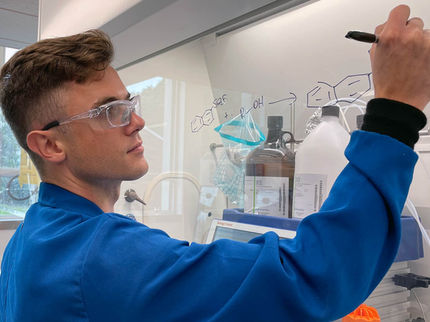Concept for more efficient precious metal catalysts
New approach for the production of resource-saving catalysts uses different interactions of precious metals with different carrier materials
Advertisement
More than 90 percent of all chemical products in our everyday lives use a catalyst in the course of their production. catalysts make chemical reactions faster, can reduce their energy consumption and make some reactions possible in the first place. Researchers at the Karlsruhe Institute of Technology (KIT) have developed a concept that increases the stability of precious metal catalysts and reduces the amount of precious metal used. Their study has been published as a "Very Important Paper" in the journal Angewandte Chemie.
Aiming for the best possible catalyst performance
Precious metal catalysts are used in numerous processes in the chemical industry. Reducing the amount of precious metal used is an important contribution to conserving resources. "Our approach drastically improves catalyst stability and ensures the formation of active precious metal clusters even at low precious metal contents," says Dr. Daria Gashnikova from the Institute of Technical Chemistry and Polymer Chemistry (ITCP) at KIT, the lead author of the study. In order to achieve the best possible catalyst performance with the lowest possible use of precious metals, the researchers at the ITCP took an atom-by-atom look at the frequently used supported catalysts. In these supported catalysts, the material on which the reaction takes place is finely distributed on a carrier material in the form of small nanoparticles. These clusters are dynamic and change their structure depending on the reaction conditions. They can combine with each other and grow into larger particles so that fewer surface atoms are available for the reaction. However, they can also break down into individual atoms, which cannot do their work on their own. Both of these factors reduce the performance of catalysts. The researchers at the ITCP solve this problem in their novel concept by utilizing the different interactions of precious metals with different carrier materials.
Newly designed carrier material - precious metal atoms collect on cerium oxide "islands"
"Precious metals, such as palladium, bind very strongly to cerium oxide, but interact only weakly with aluminum oxide," explains Gashnikova. "That's why we applied palladium to tiny cerium oxide 'nano-islands', which in turn were finely distributed on aluminum oxide," says the scientist. The optimization of the carrier material ensures that the precious metal atoms preferentially collect on the cerium oxide islands. The distance between the islands on the one hand and the limited mobility of palladium when it is on cerium oxide on the other prevent both the formation of clusters that are too large and the decomposition of the palladium into individual atoms. The size of the precious metal clusters is defined by the number of precious metal atoms on the individual cerium oxide islands. "The dream is to walk this fine golden line for the entire lifetime of the catalyst and, if possible, to stabilize small particles consisting of only ten to 50 atoms," says Professor Jan-Dierk Grunwaldt, member of the ITCP institute management and spokesperson for the Collaborative Research Centre (CRC) 1441 "TrackAct".
Collaborative Research Center 1441 "TrackAct"
In the SFB 1441 TrackAct, which is funded by the German Research Foundation, more than 20 working groups are working on an interdisciplinary basis to better understand the fundamental catalytic processes. The concept developed at the ITCP is one of the key results of the CRC, which was launched in 2021 and in which KIT is conducting research together with TU Munich and the Deutsches Elektronen-Synchrotron DESY. "The fundamental understanding of the structure and mechanism of catalysts will provide us with a kind of toolbox with which we can design optimal catalysts for each individual process in a knowledge-based and efficient manner," says Dr. Florian Maurer, coordinator of TrackAc " and co-author of the study.
Note: This article has been translated using a computer system without human intervention. LUMITOS offers these automatic translations to present a wider range of current news. Since this article has been translated with automatic translation, it is possible that it contains errors in vocabulary, syntax or grammar. The original article in German can be found here.
Original publication
Daria Gashnikova, Florian Maurer, Eric Sauter, Sarah Bernart, Jelena Jelic, Paolo Dolcet, Carina B. Maliakkal, Yuemin Wang, Christof Wöll, Felix Studt, Christian Kübel, Maria Casapu, Jan‐Dierk Grunwaldt; "Highly Active Oxidation Catalysts through Confining Pd Clusters on CeO2 Nano‐Islands"; Angewandte Chemie International Edition, 2024-7-17




























































